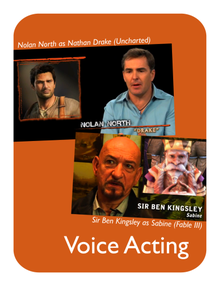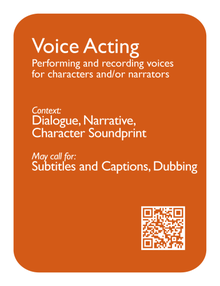Difference between revisions of "Voice Acting"
ValterAlves (Talk | contribs) (The page for the sound design pattern/card named Voice Acting) |
ValterAlves (Talk | contribs) m |
||
| (34 intermediate revisions by the same user not shown) | |||
| Line 2: | Line 2: | ||
| name =Voice Acting | | name =Voice Acting | ||
| deckversion =1.0 | | deckversion =1.0 | ||
| − | | | + | | v10synopsis =Performing and recording voices for characters and/or narrators |
| + | | v20synopsis =Performing and recording voices for characters and/or narrators | ||
| patternpresentation = | | patternpresentation = | ||
| cardpresentation= | | cardpresentation= | ||
| − | | | + | | v10frontface =VoiceActing-front-v10.png |
| − | | | + | | v10backface =VoiceActing-back-v10.png |
| + | | v20frontface =VoiceActing-front-v20.png | ||
| + | | v20backface =VoiceActing-back-v20.png | ||
| screenshots= | | screenshots= | ||
| − | | | + | | v10rel-tag1=Context:<br> |
| − | | | + | | v10rel1=[[Dialogue]], [[Narrative]], [[Character Soundprint]]<br> |
| − | | | + | | v10rel-tag2=May call for:<br> |
| − | | | + | | v10rel2=[[Subtitles and Captions]], [[Dubbing]]<br> |
| + | | v20rel-tag1=Context:<br> | ||
| + | | v20rel1=[[Dialogue]], [[Narrative]], [[Character Soundprint]]<br> | ||
| + | | v20rel-tag2=May call for:<br> | ||
| + | | v20rel2=[[Subtitles and Captions]], [[Dubbing]]<br> | ||
| revisions =Introduced in version 1.0 | | revisions =Introduced in version 1.0 | ||
| + | | description = | ||
| + | In some games the use of [[Dialogue]] is complemented with [[Voice Acting]]. The adoption of [[Voice Acting]] implies important decisions – beyond creativity – namely because of the costs that may be implied. | ||
| + | |||
| + | [[Voice Acting]] enhances the way [[Dialogue]] contributes to the [[Emotional Script]]. Certain features of voice such as intonation are very direct indicators of the intended emotions. Still, it is relevant to be aware that these features can be cultural dependent. | ||
| + | |||
| + | [[Voice Acting]] may add great value to the game product. Similarly to what happens in animated films, contracting well-known actors to give voice to characters not only contributes to the quality of this feature but, very importantly, it can be a powerful marketing argument. Yet, this is the kind of strategy that is prohibitive to small budget projects. | ||
| + | |||
| + | Adopting a language for the [[Voice Acting]] is an important matter. It can become a handicap for players that are not able to understand that language. As in film practice, the inclusion of [[Subtitles and Captions | Subtitles]] allows reducing the issue but it is not always convenient, namely because it takes to the visual plane a message that could otherwise be dealt with strictly through sound. [[Dubbing]] is for that matter a better approach, but again may be too costly. | ||
| + | |||
| + | A form of giving voice to characters that reduces the problems of internationalization is to design a pseudo-language. Although they are theoretically less effective in communicating exact contents, pseudo-languages have several advantages beyond tackling at the problems of language and culture. Pseudo-languages can be designed to emphasize the communication of emotions and simple signalling, through the exploration of intonation and timing {{Pending|[REF]}}. | ||
| + | | examples= | ||
| + | | ex1=<mt p="VoiceActing" g="FableIII" altg="Fable III" w="{{R16by9W}}" h="{{R16by9H}}">Sir Ben Kingsley gave voice to Sabine.</mt> | ||
| + | | ex2=<mt p="VoiceActing" g="Uncharted" altg="Uncharted: Drake's Fortune" w="{{R16by9W}}" h="{{R16by9H}}">The voice of Nathan Drake belongs to voice actor Nolan North. Nolan also gave voice to Desmond in the Assassin's Creed series and Prince in Prince of Persia, among others.</mt> | ||
| + | | ex3=<mt p="VoiceActing" g="Portal" w="{{R16by9W}}" h="{{R16by9H}}">GLaDOS was voiced by Ellen McLain, who also sang the game's well-known [[Music]] "Still Alive". Ellen also did [[Voice Acting]] in other Valve games including [[Half-Life 2]].</mt> | ||
| + | | ex4=<mt p="VoiceActing" g="HalfLife2" altg="Half-Life2" w="{{R8by5W}}" h="{{R8by5H}}"></mt> | ||
| + | | ex5=<mt p="VoiceActing" g="Halo" altg="Halo: Reach" w="{{R16by9W}}" h="{{R16by9H}}"></mt> | ||
| + | |||
| + | <!-- | ||
| + | | ex_=<mt p="VoiceActing" g="Patapon" w="{{R16by9W}}" h="{{R16by9H}}"></mt> | ||
| + | | ex_=<mt p="VoiceActing" g="PapaSangre" w="{{ViPhoneH}}" h="{{ViPhoneW}}"></mt> | ||
| + | --> | ||
| + | |||
| + | |||
| + | |external= | ||
| + | [http://www.youtube.com/watch?v=iy93LtGHyxk Testimonies from the voice actors in Fable III]<br /> | ||
| + | A compilation of Nolan North's participation in games: [http://www.youtube.com/watch?v=NXA1ISDsHVA 1], [http://www.youtube.com/watch?v=is65rL9aPws 2] <br /> | ||
| + | [http://uk.xbox360.ign.com/articles/831/831900p1.html GLaDOS Speaks]<br /> | ||
| + | [http://www.behindthevoiceactors.com/video-games/ Behind the Voice Actors [Videogames]]<br /> | ||
| + | [http://half-life.wikia.com/wiki/Ellen_McLain Ellen McLain – a voice appearing in all games of the Orange Box (includes Half-Life 2 and Portal)]<br /> | ||
| + | Dialogue Editing for Motion Pictures: A Guide to the Invisible Art by John Purcell (2007)<br /> | ||
| + | [http://filmsound.org/terminology/adr.htm ADR ("Automated" or "Automatic" Dialog Replacement)] | ||
}} | }} | ||
Latest revision as of 16:25, 26 August 2012

|

| |
| The card's front face | The card's back face |
Synopsis
| Performing and recording voices for characters and/or narrators. |
Relationships
Context:
Dialogue ![]() , Narrative
, Narrative ![]() , Character Soundprint
, Character Soundprint ![]() .
.
May call for:
Subtitles and Captions ![]() , Dubbing
, Dubbing ![]() .
.
Description
In some games the use of Dialogue is complemented with Voice Acting. The adoption of Voice Acting implies important decisions – beyond creativity – namely because of the costs that may be implied.
Voice Acting enhances the way Dialogue contributes to the Emotional Script. Certain features of voice such as intonation are very direct indicators of the intended emotions. Still, it is relevant to be aware that these features can be cultural dependent.
Voice Acting may add great value to the game product. Similarly to what happens in animated films, contracting well-known actors to give voice to characters not only contributes to the quality of this feature but, very importantly, it can be a powerful marketing argument. Yet, this is the kind of strategy that is prohibitive to small budget projects.
Adopting a language for the Voice Acting is an important matter. It can become a handicap for players that are not able to understand that language. As in film practice, the inclusion of Subtitles allows reducing the issue but it is not always convenient, namely because it takes to the visual plane a message that could otherwise be dealt with strictly through sound. Dubbing is for that matter a better approach, but again may be too costly.
A form of giving voice to characters that reduces the problems of internationalization is to design a pseudo-language. Although they are theoretically less effective in communicating exact contents, pseudo-languages have several advantages beyond tackling at the problems of language and culture. Pseudo-languages can be designed to emphasize the communication of emotions and simple signalling, through the exploration of intonation and timing [pending:[REF]].
Examples
  Portal: GLaDOS was voiced by Ellen McLain, who also sang the game's well-known Music "Still Alive". Ellen also did Voice Acting in other Valve games including Half-Life 2.
|
External Resources
Testimonies from the voice actors in Fable III
A compilation of Nolan North's participation in games: 1, 2
GLaDOS Speaks
Behind the Voice Actors [Videogames]
Ellen McLain – a voice appearing in all games of the Orange Box (includes Half-Life 2 and Portal)
Dialogue Editing for Motion Pictures: A Guide to the Invisible Art by John Purcell (2007)
ADR ("Automated" or "Automatic" Dialog Replacement)



